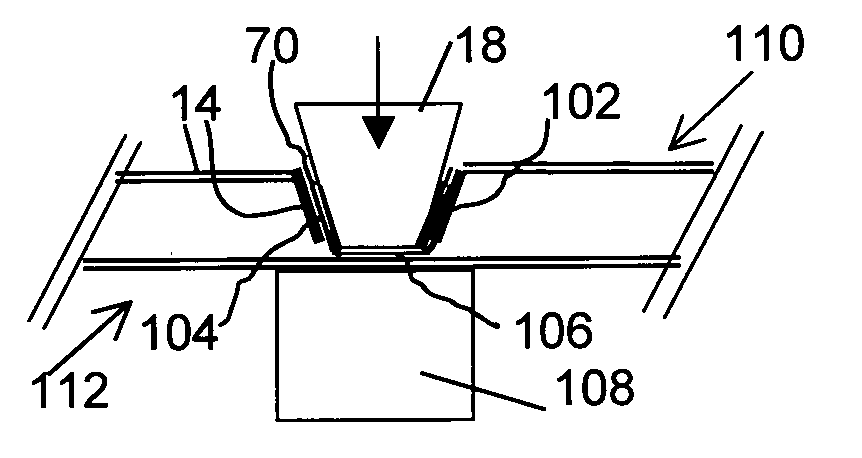Method for Manufacturing a Composite Construction Element
a construction element and composite technology, applied in the field of manufacturing a composite construction element, can solve problems such as unsatisfactory folds or angles
- Summary
- Abstract
- Description
- Claims
- Application Information
AI Technical Summary
Benefits of technology
Problems solved by technology
Method used
Image
Examples
Embodiment Construction
[0054]FIG. 1 shows a thermoplastic sandwich panel 10 which comprises an in-situ foamed core layer 12. Fiber-reinforced thermoplastic cover layers 14 and 16, respectively, are provided at the top of the foam core layer 12 and at the bottom thereof. In a first step, an incision 50 is made in the cover layer 14, parallel to the peripheral edge 100, following which a reinforcing layer 70 of a fiber-reinforced thermoplastic (either prepreg or consolidated laminate) is positioned in such a manner that the incision 50 is covered thereby and the reinforcement ends up in the desired spot in the end product. Subsequently, a hot molding stamp 18 is used to deform the top cover layer 14 at the location of the incision 50 and thus the edges which delimit the incision 50 are folded, with the additional reinforcing layer 70 also simultaneously being deformed and being pressed into the shape of a formed recess 102. See FIG. 2. The recess 102 is delimited by walls 104 and bottom 106, which are made ...
PUM
| Property | Measurement | Unit |
|---|---|---|
| Angle | aaaaa | aaaaa |
| Angle | aaaaa | aaaaa |
| Temperature | aaaaa | aaaaa |
Abstract
Description
Claims
Application Information
 Login to View More
Login to View More - R&D
- Intellectual Property
- Life Sciences
- Materials
- Tech Scout
- Unparalleled Data Quality
- Higher Quality Content
- 60% Fewer Hallucinations
Browse by: Latest US Patents, China's latest patents, Technical Efficacy Thesaurus, Application Domain, Technology Topic, Popular Technical Reports.
© 2025 PatSnap. All rights reserved.Legal|Privacy policy|Modern Slavery Act Transparency Statement|Sitemap|About US| Contact US: help@patsnap.com



